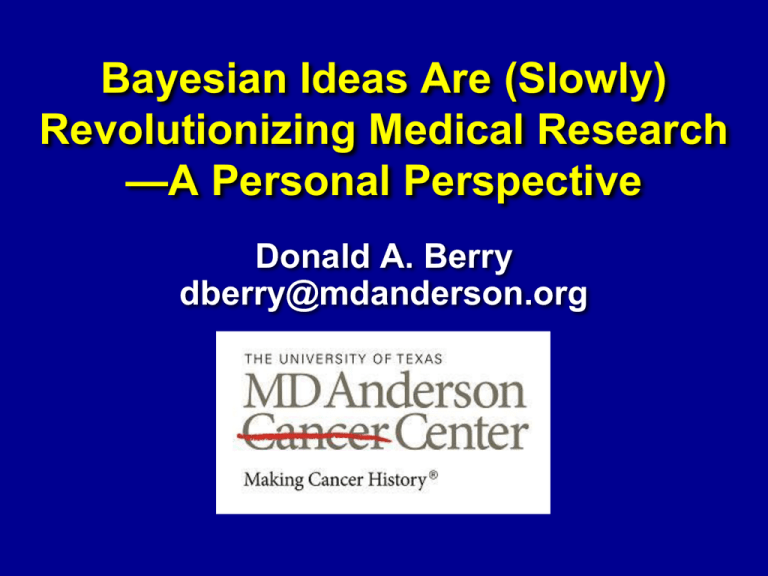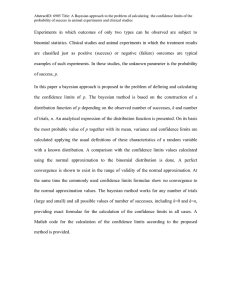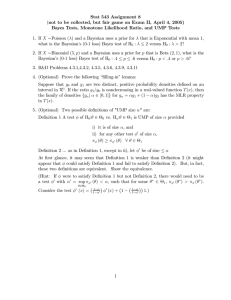Bayesian Ideas Are (Slowly) Revolutionizing Medical Research —A Personal Perspective Donald A. Berry
advertisement

Bayesian Ideas Are (Slowly) Revolutionizing Medical Research —A Personal Perspective Donald A. Berry dberry@mdanderson.org Biased History of Biostatistics 1800 1940s 1900 1997: FDAMA & Bayesian Credibility 2000 1933 Medical Research Dominated by Case Study & Anecdote Frequentist Half Cent— No Bayes W.R. Thompson & Bayes Bradford Hill & RCT 2 My exposures 1970: Bandit Problems 1980: 3M Riker Labs 1990: Duke, CALGB & breast cancer 1990s: FDA & Bayes 1997: Screening mammography in 40s 1999: M.D. Anderson Cancer Center 2015: Bandit Problems! 3 Top 5 Reasons for Bayes 1. On-line learning 2. Predictive probabilities 3. Hierarchical modeling 4. Modeling generally 5. Decision analysis 4 Genetics & Bayes (80s & 90s) DNA fingerprinting BRCAPRO Doping Paternity testing Determining ancestry of corn, cabernet sauvignon, etc. using SNPs 5 6 Conclusion: BRCAPRO is an accurate counseling tool for determining the probability of carrying mutations of BRCA1 and BRCA2. Genetic testing for BRCA1 and BRCA2 is highly sensitive, missing an estimated 15% of mutations. In the populations studied, breast cancer susceptibility genes other than BRCA1 and BRCA2 either do not exist, are rare, or are associated with low disease penetrance. 7 8 9 10 Google: Mark Buchanan “The Prosecutor's Fallacy” Or: Peter Donnelly “TED Conference” 11 http://news.err.ee/sports/447c6353-50f146ee-83ce-c5470dada70f After Veerpalu Ruling, All Eyes on WADA SEE ALSO NFL Players 'Hail' Veerpalu Verdict Expert Calls Anti-Doping Agency Test Flawed “The March 26 [2013] acquittal of Andrus Veerpalu in a high-profile doping case has attracted the attention of major sports organizations, and other athletes may follow in the Estonian skier's footsteps to dispute test results issued by the World Anti-Doping Agency.” 12 “Truth and justice of our Andrus Veerpalu” “We identify with our heroes; they become a part of our self-image. … there are some beautiful messages in the vast numbers on ‘We Believe’ page. … these people [are] unwilling to count themselves cheats. So, their moral beliefs were expressed by faith in our hero.” http://news.postimees.ee/1183132/editorial-truth-and-justice-of-our-andrus-veerpalu/ 13 “Thus, Estonian mathematician [biostatistician] Krista Fischer with her academic colleagues from Tartu and US has defeated an organisation [WADA] claiming to be able, in an academically clean manner, to stand for clean sports.” http://news.postimees.ee/1183132/editorial-truth-and-justice-of-our-andrus-veerpalu/ 14 An Extreme in Junk Science Establishing “decision limits” of HGH isoform ratio Determining comparison: 106 “non-dopers” How selected? False-positive rate: 1 in 10,000! 15 From dope to corn … 16 17 Analysis was applied to soybeans, cattle, sunflowers, cabernet sauvignon, etc. 18 19 Back up 12 years to 1997 U.S. NIH Consensus Conference: Mammography for women in 40s “The Panel concludes that the data currently available do not warrant a universal recommendation for mammography for all women in their forties. Each woman should decide for herself whether to undergo mammography.” 20 Bayesian metaanalysis of randomized trials in 1997 21 Berry JNCI 1998 … with 2009 updates Mortality reduction = 18% Updates K S C O E U H G Bayes estimates M 22 Berry JNCI 1998 “A way to understand risks is to relate them with risks that are familiar. For example, the estimated average of 5 days of life lost if a woman in her early forties delays mammography for 10 years is similar to that for not wearing a seat belt over 20 years of typical automobile travel, of riding a bicycle for 15 hours without a helmet (or 50 hours if wearing a helmet), and of gaining two ounces of body weight (and keeping them on) (41).” 23 In spite of the evidence & the expert panel, the U.S. Senate … Voted 98-0 dictating that mammography would be effective (!) for women in their 40s Withheld NIH’s budget until NCI agreed to recommend screening for women in their 40s [update] 24 2002 Cochran Review U.S. Senate again jumps into the fray Then, in 2005 … 25 CNN: Statistical Blitz Helps Pin Down Mammography Benefits 26 27 Trends in Female Breast Cancer Death Rates, U.S., 1975-2006 Rate per 100,000 African American 28 U.S. Breast Cancer Mortality (Age Standardized to U.S. Population in 2000) BC Deaths / 100,000 Population 35 24% 30 25 20 15 10 5 0 1975 1980 1985 1990 1995 2000 29 Age-standardised mortality rates, breast cancer, females, UK, 1971-2008 45 35 36% 30 25 20 15 10 5 2007 2004 2001 1998 1995 1992 1989 1986 1983 1980 1977 1974 0 1971 Rate per 100,000 40 Year of death 30 Fig 1 Temporal trends in breast cancer mortality in European countries. 19802008 Autier P et al. BMJ 2010;341:bmj.c3620 31 ©2010 by British Medical Journal Publishing Group CISNET Population Models —One Bayesian Common inputs Background trends Screening behavior Diffusion of new treatments Simulation or analytical models 7 different breast cancer models BC incidence & mortality Other common inputs 32 Mammography Screening Over Time, Women ages 40-79 33 Adjuvant Therapy Dissemination Ages 50-69, node-positive None Polychem Both Tamoxifen 34 Model W’s Mortality Rate per 100,000 Women 40-79 under Various Scenarios 70 60 No Screening or Treatment 50 Screening only Treatment only 40 Both US actual 30 20 10 0 1975 1980 1985 1990 1995 2000 Year 35 Percent reductions in BC mortality due to adjuvant Rx and screening 30 Due to Adjuvant Treatment 25 E 20 R W M 15 S G D 10 5 0 0 5 10 15 20 Due to Screening 25 30 36 Bayesian Models (M) 37 37 Model M Simulations E R M G W S D 38 39 Model M Simulations Norway Added R M N G E W S D 40 Conclusions from Model M Bayesian approach ideally suited for “comparative effectiveness research” Bayesian approach encompasses other six models Probability distributions of parameters are necessary for assessing predictive uncertainty 41 NYT Editorial “What seems most important is that each team found at least some benefit from mammograms. The likelihood that they are beneficial seems a lot more solid today than it did four years ago, although the size of the benefit remains in dispute” 42 CISNET 2009 USPSTF employed modeling + RCTs Recommendation: Repeat of 1997 43 San Antonio Breast Cancer Symposium, Cancer Therapy and Research Center at UT Health Science Center – Dec 10-14, 2013 44 This presentation is the intellectual property of Donald Berry. Contact dberry@mdanderson.org for permission to reprint or distribute. Reactions to 2009 USPSTF New York Times: New Guidelines on Breast Cancer Draw Opposition LA Times: Mammogram guidelines spark heated debate. A government panel's recommendation that women under 50 do not need regular mammograms is attacked by oncologists, gynecologists and cancer groups Boston Globe: Breast screening advice upended Obama critics charge “rationing healthcare” and “death squads” 45 CISNET Contributions to 2009 USPSTF Recommendations Mortality for Biennial vs annual screening Benefit for women in 40s Context of modern chemotherapy & hormonal therapy False positives/biopsies 46 Update to today Cooler heads are prevailing Look for 2014 USPSTF update: Focus of overdiagnosis 47 The Coming Bayesian Tsunami of Clinical Development Janet Woodcock Dir CDER FDA (2006) “Improved utilization of adaptive and Bayesian methods” could help resolve low success rate of and expense of phase 3 clinical trials 49 Current use of Bayesian designs MDACC (> 300 trials) Device companies (> 25 PMAs, many IDEs) Drug companies (Most of top 40; many biotechs) NIH & NCI? 50 Bayesian adaptive trials Stopping early (or late) Efficacy Futility Dose finding (& dose dropping) Seamless phases Population finding Adaptive randomization Ramping up accrual 51 Why? Smaller trials (usually!) More accurate conclusions Addresses more questions Better treatment of patients in trials 52 53 Adaptive Randomization Relation to “bandit problems”? 54 Example: Troxacitabine in AML Standard design Our design R A N D O M I Z E Idarubicin Ara-C Trox Idarubicin Trox Ara-C Adaptive n = 25 randomization to learn, while n = 25 effectively treating n = 25 patients in trial 55 Adaptive Randomization Assign with higher probability to better performing therapies TI dropped after 24th patient Trial stopped after 34 patients 56 Summary of AML trial results CR by 50 days: IA 10/18 = 56% TA 3/11 = 27% TI 0/5 = 0% 57 Cure Magazine (2006) “I see no rationale to further delay moving to these designs,” says Dr. Giles, who is currently involved in eight Bayesian-based leukemia studies. “They are more ethical, more patient-friendly, more conserving of resources, more statistically desirable.” 58 Simulations Usually Required To find operating characteristics: Type I error rate Power Sample size distribution Trial duration Amount of drug required Prospective design essential Longitudinal modeling Many scenarios Accrual rate matters 59 Two Recent Bayesian Clinical Trials … with Smaller Sample Size Bayesian predictive probabilities Longitudinal modeling 60 61 A Bayesian statistical design was used with a range in sample size from 600 to 1800 patients. 62 Example from Critical Path Initiative Type II diabetes Seamless Phase II/III: Dose finding via plus confirmation Active comparator & placebo Primary endpoint: Clinical Utility Index (12 months) 63 Some Details Phase II: 7 doses experimental drug, adaptively randomized Phase III 1 or 2 doses experimental drug Sample size via predictive power considering available Phase II data Adaptive transition: Bayesian predictive probs Both phases driven by CUI Role of longitudinal modeling 64 Clinical Utility Index Exp – AC 12 mos 0 0 0 0 Exp – AC 12 mos Exp – P 12 mos Exp – P 12 mos Dose-response modeling Longitudinal modeling 65 October 22, 2012 Lilly Diabetes Announces Positive Results of Phase III Trials of Dulaglutide in Type 2 Diabetes Company Shares Top-line Results on 3 Completed AWARD Trials INDIANAPOLIS, Oct. 22, 2012 /PRNewswire/ -- Eli Lilly and Company (NYSE: LLY) today announced positive top-line results of three completed Phase III AWARD trials for dulaglutide, an investigational, long-acting glucagon-like peptide 1 (GLP-1) analog being studied as a once-weekly treatment for type 2 diabetes. Primary efficacy endpoints, as measured by reduction in hemoglobin A1c (HbA1c) at the 1.5 mg dose, were met in three studies (AWARD-1, AWARD-3 and AWARD-5). Having met the primary endpoints, superiority for HbA1c lowering was examined, and both doses of dulaglutide (0.75mg and 1.5mg) demonstrated statistically superior reduction in HbA1c from baseline compared to: exenatide twice-daily injection at 26 weeks (AWARD-1); metformin at 26 weeks (AWARD-3); and sitagliptin at 52 weeks (AWARD-5). 66 When the I-SPY 2 trial launched in 2010, oncologists heralded it as the future of cancer research. Five pharmaceutical companies put aside their differences to participate in the landmark phase 2 breast cancer trial, which adaptively and efficiently randomized patients to one of seven experimental therapies. Now, even as I-SPY 2 propels its first two drugs into phase 3 trials, researchers in other areas of medicine are catching on to the benefits of this collaborative approach. On 11 December, Europe's Innovative Medicines Initiative (IMI) announced a €53 million call for proposals for a similarly designed trial in Alzheimer's disease. Already, at least 12 drug companies are keen to participate. 67 68 Two of BC’s federal grants: PCORI: Adaptive Design Guidance for Clinical Trials FDA/NIH Regulatory Science 69 "Our current approach [to trials] is horribly inefficient, and we need to do something better," says Roger Lewis, an emergency medicine physician at Harbor-University of California, Los Angeles, Medical Center. Lewis helps advise a company called Berry Consultants … 70 Lewis and Berry, along with emergency medicine physician William Barsan at the University of Michigan, will be studying whether "adaptive" trial designs that incorporate new information in midcourse can answer medical questions. They also want to learn what concerns researchers might have about this approach. 71 I-SPY2 http://clinicaltrials.gov/ct2/show/ NCT01042379?term=I-SPY2&rank=1 72 For example, in 2010, the Biomarkers Consortium–a public-private partnership that includes the NIH, the FDA, patient groups, and pharmaceutical and biotech–initiated a groundbreaking trial in breast cancer to predict drug responsiveness based on the presence or absence of genetic and biological markers, … I-SPY 2 (ClinicalTrials.gov NCT01042379). 73 74 75 Effects of I-SPY Approaches Match drugs with biomarker signatures Savings from common control Better therapies move thru faster Successful drug/biomarker pairs graduate to small, focused, more successful Phase 3 based on Bayesian predictive probabilities Offspring of I-SPY 2: melanoma, GBM, Alzheimer’s, HIV, acute heart failure, SARI/H1N1, … 76 I-SPY 2 is a prototypic “platform trial” 5 pharmaceutical companies, going on 6 7 experimental agents (2 graduated), going on 8 77 Merck 78 Biased History of Biostatistics 1800 1900 1940s 1997: FDAMA & Bayesian Credibility 2000 1933 Frequentist Half Cent— No Bayes Medicine Dominated by Case Study & Anecdote W.R. Thompson & Bayes Bradford Hill & RCT 79





